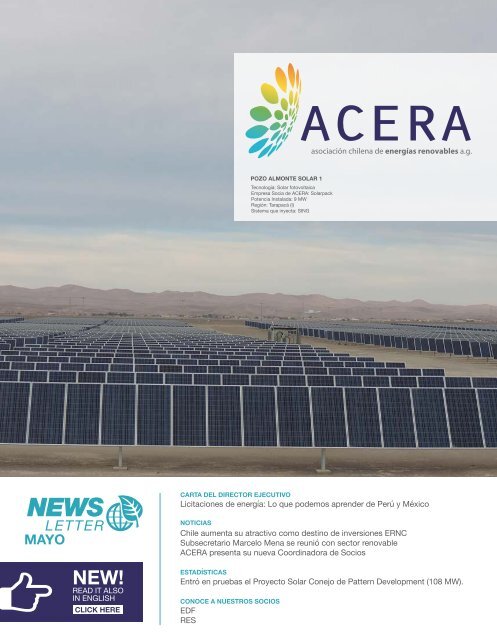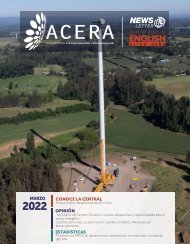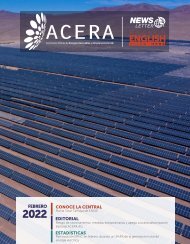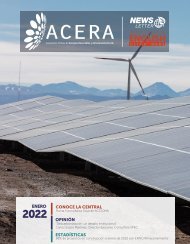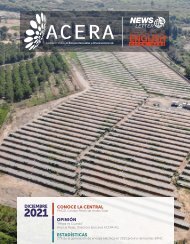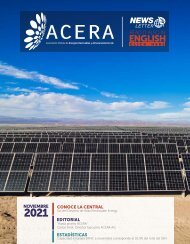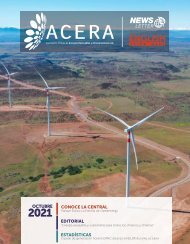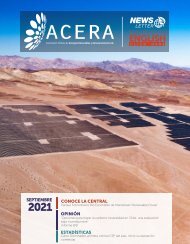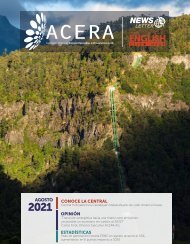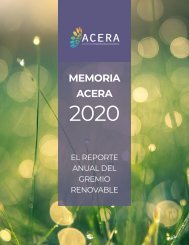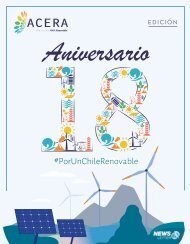Newsletter ACERA Mayo 2016
You also want an ePaper? Increase the reach of your titles
YUMPU automatically turns print PDFs into web optimized ePapers that Google loves.
POZO ALMONTE SOLAR 1<br />
Tecnología: Solar fotovoltaica<br />
Empresa Socia de <strong>ACERA</strong>: Solarpack<br />
Potencia Instalada: 9 MW<br />
Región: Tarapacá (I)<br />
Sistema que inyecta: SING<br />
MAYO<br />
NEW!<br />
READ IT ALSO<br />
IN ENGLISH<br />
CLICK HERE<br />
CARTA DEL DIRECTOR EJECUTIVO<br />
Licitaciones de energía: Lo que podemos aprender de Perú y México<br />
NOTICIAS<br />
Chile aumenta su atractivo como destino de inversiones ERNC<br />
Subsecretario Marcelo Mena se reunió con sector renovable<br />
<strong>ACERA</strong> presenta su nueva Coordinadora de Socios<br />
ESTADÍSTICAS<br />
Entró en pruebas el Proyecto Solar Conejo de Pattern Development (108 MW).<br />
CONOCE A NUESTROS SOCIOS<br />
EDF<br />
RES
EDITORIAL<br />
Carlos Finat<br />
Director Ejecutivo<br />
Licitaciones de energía: Lo que podemos aprender de Perú y México<br />
En los últimos meses, las licitaciones de energía<br />
ocurridas en Perú y México han llamado la atención de<br />
los medios de comunicación, destacando los bajos<br />
precios alcanzados por las ofertas ganadoras con<br />
proyectos ERNC.<br />
Como resultado de la licitación efectuada durante<br />
febrero de este año en Perú, se obtuvo un precio<br />
promedio de 43 USD/MWh, con un mínimo de 36,8<br />
USD/MWh ofrecido por energía eólica, en tanto que en<br />
México se alcanzó un promedio de 47,8 USD/MWh<br />
con una oferta mínima de 35,4 USD/MWh con energía<br />
solar. Los valores contrastan con los 79 USD/MWh que<br />
se lograron en la licitación 2015/2 que se adjudicó en<br />
su totalidad a ERNC en Chile en octubre de 2015.<br />
A la luz de las diferencias, surge naturalmente la duda<br />
sobre qué se podría aprender de las licitaciones<br />
realizadas en México y Perú para reducir aún más los<br />
precios de la energía en nuestro país. Esta interrogante<br />
surgió clara y públicamente desde el sector minero en<br />
la reciente Cumbre de Energía y Minería efectuada en<br />
Santiago el 16 de mayo recién pasado.<br />
En <strong>ACERA</strong> hemos hecho un análisis de los procesos<br />
licitatorios de esos países y creemos que se pueden<br />
derivar varios aprendizajes que permitirían reducir los<br />
costos de las ERNC en forma significativa si se<br />
aplicaran en Chile, ya sea en las licitaciones de energía<br />
para empresas distribuidoras o en licitaciones de<br />
clientes libres.<br />
En primer lugar, en los países mencionados la energía<br />
se compra a los generadores ERNC adjudicados en<br />
sus respectivas barras de inyección. Así, los<br />
generadores ERNC no enfrentan el peligro de<br />
desacople de costos marginales, riesgo que en Chile<br />
debe ser cubierto por los mismos generadores y en un<br />
contexto de alta volatilidad de dichos costos. En el<br />
caso de Chile, el punto de venta de la energía es una<br />
barra distinta de su punto de inyección y entre ellos<br />
puede haber fuertes diferencias de costo marginal,<br />
debido a restricciones de nuestro ajustado sistema de<br />
transmisión.<br />
Otra gran diferencia, es que en aquellas licitaciones a<br />
los generadores adjudicados se les asegura la compra<br />
de toda su producción. De esta forma, no quedan<br />
expuestos a la incertidumbre que se da en las<br />
licitaciones nacionales, donde al generador sólo se le<br />
asegura la compra de una proporción de la demanda<br />
de los clientes regulados, existiendo entonces el riesgo<br />
de que parte de su producción deba ser colocada en el<br />
volátil mercado spot.<br />
Así varios otros aprendizajes podrían ser<br />
perfectamente aplicables a nuestros procesos de<br />
licitación, ya sean para distribuidoras o para clientes<br />
libres, de manera de aportar en la disminución de los<br />
precios de la energía en Chile. <strong>ACERA</strong> tiene la mejor<br />
disposición para colaborar en los procesos que sean<br />
necesarios para diseñar las adecuaciones de la<br />
normativa vigente y a las bases de licitación, para<br />
aprovechar estos aprendizajes y avanzar hacia energía<br />
más limpia, segura, inclusiva y competitiva, como lo<br />
requiere Chile.<br />
El análisis de las licitaciones de Perú y México puede<br />
encontrarlo en la siguiente MINUTA.
NOTICIAS<br />
TU EMPRESA<br />
PODRÍA ESTAR<br />
AQUÍ<br />
MEDIA PÁGINA VERTICAL<br />
<strong>ACERA</strong> CELEBRA SU PRIMERA ASAMBLEA<br />
GENERAL DEL AÑO<br />
Contacto<br />
Paula Vicens<br />
paula.vicens@acera.cl<br />
+562 22363348<br />
El día 10 de mayo <strong>ACERA</strong> realizó su primera Asamblea<br />
General del año en el Auditorio de su empresa socia<br />
Guerrero Olivos. Esta actividad representa el principal<br />
encuentro oficial del gremio y el encargado de la<br />
apertura fue el Vicepresidente de la Asociación José<br />
Ignacio Escobar, quien destacó los grandes avances<br />
que ha tenido <strong>ACERA</strong> en el último tiempo, pero sin<br />
olvidar que es fundamental seguir consolidando el<br />
trabajo unido como sector para seguir avanzando en los<br />
temas que quedan pendientes. Posteriormente, se dio<br />
paso a la Cuenta anual 2015 en voz del Director<br />
Ejecutivo Carlos Finat, además de abrir un espacio de<br />
conversación con los socios presentes sobre el sector<br />
de energía en lo que va del año y los próximos desafíos<br />
que enfrentará.
NOTICIAS<br />
CHILE AUMENTA SU ATRACTIVO COMO DESTINO DE<br />
INVERSIONES ERNC<br />
El estudio anual de la consultora Ernst & Young, RECAI (Renewable<br />
Energy Country Attractiveness Index), que refleja los países más<br />
atractivos para las inversiones en Energías Renovables, entregó una<br />
nueva sorpresa para Chile. Nuestro país subió cinco puestos en<br />
comparación con el análisis 2015 dejándolo en el cuarto lugar, sólo<br />
después de Estados Unidos, China e India. El ranking incluye además a<br />
dos latinoamericanos dentro de sus Top 10, con Brasil en el sexto lugar<br />
y México en el séptimo. E&Y destaca que Chile, a pesar de ser es un<br />
mercado relativamente pequeño, es uno de los primeros en el mundo en<br />
permitir que proyectos renovables económicamente viables compitan<br />
directamente con las energías convencionales y que -a diferencia de<br />
EE.UU.- se mantiene en alza. “Este ranking es un reconocimiento<br />
internacional al acertado marco regulatorio que se ha implementado en<br />
los últimos dos años y al intenso y perseverante trabajo que todas las<br />
empresas involucradas con el sector ERNC han realizado para lograr<br />
una matriz energética más limpia y económica para Chile”, señaló al<br />
respecto Carlos Finat, Director Ejecutivo de <strong>ACERA</strong>.<br />
SUBSECRETARIO MARCELO MENA SE REUNIÓ CON SECTOR ERNC<br />
En el marco del Anteproyecto del Plan de Acción de Cambio Climático<br />
2017-2022 (PANCC-II), del Ministerio de Medio Ambiente -el cual se<br />
encuentra en consulta pública hasta el 22 de julio de <strong>2016</strong>-, <strong>ACERA</strong> organizó<br />
una reunión con el Subsecretario Marcelo Mena, de manera que sus<br />
empresas socias pudieran tener un acercamiento con la primera fuente<br />
sobre los avances y desafíos del país en temas medioambientales. El nuevo<br />
Plan de Acción se desarrolla en un escenario de mayor conocimiento y de<br />
avances concretos obtenidos a través de lo vivido con el Plan de Acción<br />
Nacional de Cambio Climático 2088-2012 (PANCC I), aspirando así a<br />
resultados más próximos y basados en la experiencia. Esta actividad se<br />
suma a las iniciativas que <strong>ACERA</strong> ha impulsado con el apoyo del Ministerio<br />
del Medio Ambiente para estar alineados con los compromisos asumidos<br />
por Chile en la pasada COP21.
NOTICIAS<br />
<strong>ACERA</strong> PRESENTA SU NUEVA COORDINADORA DE SOCIOS<br />
En mayo se unió Paula Vicens al Equipo de <strong>ACERA</strong> como Coordinadora de<br />
Socios. Paula será el contacto directo entre la Asociación y sus empresas<br />
asociadas, además de ser la encargada de atraer nuevos interesados en<br />
sumarse a esta aventura de ser parte del gremio de las ERNC. Ella es<br />
Relacionadora Pública y Master en Estudios Internacionales del IEI de la<br />
Universidad de Chile, tiene más de quince años de experiencia laboral y hoy<br />
viene con todas las ganas para apoyar el crecimiento de la Asociación y<br />
asimismo del sector. Les dejamos su contacto para que puedan conocerla<br />
desde ya: paula.vicens@acera.cl<br />
TU EMPRESA<br />
PODRÍA ESTAR<br />
AQUÍ<br />
MEDIA PÁGINA HORIZONTAL<br />
Contacto<br />
Paula Vicens<br />
paula.vicens@acera.cl<br />
+562 22363348
ESTADÍSTICAS<br />
RESULTADOS ERNC<br />
Durante el mes de mayo, entraron a calificación 3 proyectos ERNC, sumando 865 MW. Del total, dos fueron de energía solar<br />
fotovoltaica (149 MW) y uno combinado de tecnología solar fotovoltaica con CSP, sumando 716 MW. Dentro de estos proyectos<br />
destaca la planta FV Laura Solar, de Solarpack (80 MW).<br />
Durante este mes, se aprobaron medioambientalmente tres proyectos por 177 MW. Dentro de estos, destaca la Planta<br />
Termosolar Camarones de Elecnor de 105 MW.<br />
En la última resolución exenta N° 397 del 4 de mayo de <strong>2016</strong>, que actualiza y comunica obras de generación, se declaró en<br />
construcción el Parque Eólico Cabo Leones de 115 MW, de Ibereólica.<br />
En mayo también entraron en pruebas los proyectos Solar Conejo, de Pattern Development (108 MW) y La Sila (1,9MW). Fueron<br />
entregados a explotación económica los proyectos Parque Solar Carrera Pinto, de Enel Green Power (20 MW), Solar Bellavista<br />
(3 MW), Solar Raso Power PMGD (2,7 MW) e Hidro Molino Villarrica PMGD (0,6 MW).<br />
PROYECTOS ERNC POR ESTADO DE AVANCE<br />
10.000<br />
Tipo de Tecnología<br />
Potencia (MW)<br />
8.000<br />
En operación En construcción Aprobado En calificación Total<br />
6.000<br />
Energía Eólica<br />
Solar PV<br />
948<br />
1.247<br />
518<br />
1.917<br />
6.759<br />
9.545<br />
1.708<br />
5.855<br />
9.933<br />
18.576<br />
4.000<br />
CSP<br />
Bioenergía<br />
0<br />
477<br />
110<br />
0<br />
1.222<br />
171<br />
1.435<br />
80<br />
2.767<br />
728<br />
2.000<br />
0<br />
Energía Eólica Solar PV CSP Bioenergía Geotérmica Mini hidro ERNC PSH Termosolar<br />
Potencia de proyectos en operación (MW)<br />
Potencia de proyectos en construcción (MW)<br />
Geotérmica<br />
Mini hidro ERNC<br />
PSH (Pumped<br />
storage hydro)<br />
Termosolar<br />
Total<br />
0<br />
576<br />
0<br />
48<br />
25<br />
0<br />
70<br />
321<br />
300<br />
0<br />
122<br />
0<br />
118<br />
1.043<br />
300<br />
39 0 0 0 39<br />
3.287 2.617 18.388 9.200 33.492<br />
Potencia de proyectos aprobados (MW)<br />
Potencia de proyectos en calificación (MW)<br />
POTENCIA ERNC INSTALADA Y EN CONSTRUCCIÓN POR SISTEMA<br />
Potencia instalada SIC (MW)<br />
Mini Hidro ERNC 536<br />
Solar PV 905<br />
Potencia instalada SING (MW)<br />
Mini Hidro ERNC 16<br />
Solar PV 339<br />
Energía Eólica<br />
850<br />
Energía Eólica<br />
90<br />
Bioenergía<br />
477<br />
Potencia en construcción SIC (MW)<br />
Potencia en construcción SING (MW)<br />
Mini Hidro ERNC 52<br />
Solar PV 1.085<br />
Solar PV<br />
CSP<br />
832<br />
110<br />
Energía Eólica<br />
406<br />
Energía Eólica<br />
112<br />
Geotérmica<br />
48<br />
Energía Eólica<br />
Solar PV CSP Bioenergía Geotérmica Mini Hidro ERNC<br />
(*) Potencia instalada considera proyectos en explotación comercial y en etapa de pruebas.
ESTADÍSTICAS<br />
Durante abril, las ERNC aportaron un 11,06% de la energía total del sistema, lo que acumula un 11,05% en lo que va del año.<br />
La bioenergía fue la que más contribuyó con un 3,79%, lo que significó una disminución del 8,07% con respecto a la<br />
generación del mes anterior. Le siguió la energía eólica con un 2,79%, con un aumento de energía del 28,16% con respecto a<br />
marzo. La energía solar estuvo en tercer lugar con 2,53%, lo que representó una disminución del 16,78%. En cuarto lugar,<br />
estuvo la energía proveniente de centrales mini hidro, con un 1,94%, lo que corresponde a una caída del 7,02% con respecto<br />
a marzo de este año.<br />
PORCENTAJE DE PARTICIPACIÓN DE LAS ERNC EN EL SISTEMA<br />
14%<br />
12%<br />
10%<br />
8%<br />
6%<br />
4%<br />
2%<br />
2012<br />
mar.<br />
abr.<br />
may.<br />
jun.<br />
jul.<br />
ago.<br />
sept.<br />
oct.<br />
nov.<br />
dic.<br />
ene.<br />
feb.<br />
mar.<br />
abr.<br />
may.<br />
jun.<br />
jul.<br />
ago.<br />
sept.<br />
oct.<br />
nov.<br />
dic.<br />
ene.<br />
feb.<br />
mar.<br />
2013 2014 2015 <strong>2016</strong><br />
abr.<br />
Solar Eólico Bioenergía Mini hidro ERNC Total Reconocido Obligación<br />
Porcentaje de participación ERNC Abril <strong>2016</strong> YTD<br />
Reconocido<br />
9,14%<br />
Obligación<br />
4,09%<br />
Bioenergía 3,79%<br />
Eólica<br />
2,79%<br />
Mini hidro ERNC<br />
1,94%<br />
Solar PV<br />
2,53%<br />
Total<br />
11,06%<br />
8,74%<br />
4,12%<br />
3,52%<br />
2,73%<br />
2,12%<br />
2,68%<br />
11,05%<br />
La información de este gráfico está desfasada en dos meses.<br />
Fuente de gráficos: Elaboración propia en base a información de CNE, CDEC-SIC, CDEC-SING y SEIA.<br />
BIENVENIDA A LOS<br />
NUEVOS SOCIOS
CONOCIENDO A NUESTROS SOCIOS<br />
EDF EN Chile<br />
Daniel Fernández de Salamanca<br />
CEO<br />
daniel.fsalamanca@edf-en.com<br />
Daniel es Ingeniero Civil de Caminos, Canales y Puertos de la Universidad<br />
Politécnica de Madrid y Máster en Administración de Empresas por el IESE.<br />
Tiene más de quince años en el sector de las energías renovables,<br />
trabajando en la filial de EDF EN en España y en otras empresas del sector<br />
como Iberdrola Renovables y Acciona Energía. Fue consejero de UNEF,<br />
Asociación española de la Industria Fotovoltaica y de APPA, Asociación<br />
nacional de Productores de Energías Renovables.<br />
¿Cuáles son las novedades o cambios de su empresa en el último tiempo?<br />
EDF EN ha apostado por el desarrollo y la operación de proyectos ERNC a largo<br />
plazo en el mercado eléctrico chileno, con oficina y equipo local en el país desde<br />
marzo de 2015. Su estrategia es participar en proyectos en desarrollo con el<br />
objeto de aportar valor con su experiencia en la construcción y operación de las<br />
plantas, invirtiendo al 50% con socios globales o locales.<br />
¿Cuáles son los principales proyectos -o temas- que están trabajando en el<br />
último tiempo en torno a las ERNC o el medioambiente? En caso de ser plantas<br />
de generación, dónde se ubican? ¿Cuáles son sus características centrales?<br />
Nuestro primer proyecto es una central solar fotovoltaica de 150MW en la II<br />
Región, en la Municipalidad de Sierra Gorda. Este primer proyecto se encuentra<br />
en construcción y tiene previsto comenzar a vender energía en el segundo<br />
semestre de <strong>2016</strong>. Posteriormente, tenemos en cartera varios proyectos solares y<br />
eólicos cuyas inversiones se realizarán entre <strong>2016</strong> y 2019.<br />
¿Qué elementos caracterizan y/o diferencian a su empresa?<br />
EDF ENERGIES NOUVELLES es un actor líder internacional en el desarrollo,<br />
construcción y operación de energías renovables. Tenemos presencia en 22<br />
países y más de 10.500 MW entre proyectos en operación y construcción.<br />
¿Cuál considera que es la importancia de la participación ERNC en el sistema<br />
eléctrico del país?<br />
Las ERNC en Chile pueden jugar un papel esencial, aportando al sistema un<br />
porcentaje muy importante de la generación, en combinación con energía<br />
convencional baja en carbón, no contaminante. Ese debe ser el objetivo. Para<br />
esto, es imprescindible que los organismos públicos establezcan las políticas de<br />
planificación y desarrollo adecuadas y ambiciosas para que el sistema de<br />
transmisión permita esta penetración masiva de ERNC.<br />
¿Por qué recomendaría ser socio de <strong>ACERA</strong>?<br />
<strong>ACERA</strong> ha resultado ser el mejor canal de información para este sector y tiene una<br />
gran presencia e influencia con las instituciones públicas, lo que permite aportar<br />
la visión de la industria y participar en la definición del marco a futuro de las<br />
ERNC.<br />
RES Chile SpA<br />
Mónica Monterrosa Theran<br />
GERENTE DE DESARROLLO<br />
Monica.monterrosa@res-americas.com<br />
Mónica es Colombiana, Abogada y en proceso de obtener certificado de<br />
profesional en energía renovable. Tiene 9 años de experiencia internacional<br />
(Norte y Sur América) en desarrollo, contratos y regulación de energía. Ha<br />
trabajado con RES Américas desde el año 2009, llegando a Chile en el año<br />
2013 para iniciar la oficina de RES Chile.<br />
¿Cuáles son los productos o servicios que entrega su empresa y hacia qué tipo(s)<br />
de ERNC<br />
En RES Chile desarrollamos y construimos proyectos de energía renovable de<br />
gran escala, principalmente con recurso eólico y solar, con miras a investigar<br />
otras alternativas, tales como Energy Storage.<br />
¿Cuáles son las novedades o cambios de su empresa en el último tiempo?<br />
En RES siempre estamos en constante investigación de los recursos y opciones<br />
de generación de energía limpia, desarrollo de líneas de transmisión y Energy<br />
Storage, así como también realizamos constante investigación en la mejora de<br />
recursos ya explorados como eólica, solar y biomasa.<br />
¿Cuáles son los principales proyectos -o temas- que están trabajando en el<br />
último tiempo en torno a las ERNC o el medioambiente? En caso de ser plantas<br />
de generación, dónde se ubican? ¿Cuáles son sus características centrales?<br />
Plantas de generación de energía limpia, a lo largo de Chile. El único proyecto<br />
público es el Parque Eólico Piñón Blanco, ubicado en la novena región. Proyecto<br />
eólico en desarrollo de potencia máxima de 163 MW.<br />
¿Qué elementos caracterizan y/o diferencian a su empresa?<br />
Somos una empresa integrada que mira proyectos desde el análisis de recurso<br />
hasta su operación. Nos diferenciamos ya que integramos desarrollo y<br />
construcción “in house”, ofreciendo sinergias que favorecen la eficacia y<br />
eficiencia en aspectos de desarrollo, construcción y operación de nuestros<br />
proyectos.<br />
¿Cuál considera que es la importancia de la participación ERNC en el sistema<br />
eléctrico del país?<br />
Chile tiene gran potencial de crecimiento y gran necesidad energética, además<br />
escasos recursos de generación eléctrica convencional y altos niveles de<br />
contaminación. Con el desarrollo de las ERNC se logrará la diversificación<br />
energética, la reducción de las tarifas eléctricas, el crecimiento competitivo de los<br />
diferentes sectores económicos y la reducción de emisiones, entre otros.<br />
¿Por qué recomendaría ser socio de <strong>ACERA</strong>?<br />
<strong>ACERA</strong> es la asociación que une a todas las empresas que trabajan o se interesan<br />
por la energía renovable. Es importante que estemos en constante comunicación<br />
y desarrollo conjunto de políticas, estándares y buenas prácticas que nos<br />
beneficien. Ésta es la labor de <strong>ACERA</strong> y es responsabilidad de todos ser parte de<br />
esta comunidad y trabajar en conjunto por un mercado estable, sustentable y en<br />
constante progreso.
<strong>ACERA</strong>, Asociación Chilena de<br />
Energías Renovables A.G.<br />
General del Canto 230, Of 601<br />
Providencia, Santiago<br />
+562 2236 3348<br />
informaciones@acera.cl<br />
@<strong>ACERA</strong>AG<br />
<strong>ACERA</strong>
POZO ALMONTE SOLAR 1<br />
Technology: Solar photovoltaic<br />
<strong>ACERA</strong> Member Company: Solarpack<br />
Installed Power: 9 MW<br />
Region: Tarapacá (I)<br />
Injected system: SING<br />
LETTER FROM THE EXECUTIVE DIRECTOR<br />
Energy tenders: learning from Peru and Mexico<br />
NEWS<br />
Chile increases its attraction as a NCRE investment destination.<br />
Undersecretary Marcelo Mena met the NCRE sector<br />
<strong>ACERA</strong> introduces its new Member Coordinator<br />
MAY<br />
STATISTICS<br />
The Conejo Solar Project of Pattern Development (108 MW) has begun<br />
its test period.<br />
MEET OUR MEMBERS<br />
EDF<br />
RES
EDITORIAL<br />
Carlos Finat<br />
Executive Director<br />
Energy tenders: learning from Peru and Mexico<br />
During the last few months, energy tenders in Peru and<br />
Mexico have drawn mass media attention,<br />
emphasizing the low prices of the NCRE projects’<br />
winning bids.<br />
As a result of the tender carried out in February of this<br />
year in Peru, an average price of 43 USD/MWh was<br />
obtained, with a minimum of 36.8 USD/MWh bid by<br />
wind energy, whereas in Mexico the average obtained<br />
was 47.8 USD/MWh with a minimum bid of 35.4<br />
USD/MWh by solar energy. These values contrast with<br />
the 79 USD/MWh of the 2015/2 bid, awarded entirely<br />
to NCRE in Chile in October, 2015.<br />
In the light of these differences, a doubt arises on what<br />
could we learn from Mexico and Peru´s tenders in order<br />
to reduce even more our country’s energy prices. This<br />
question was clearly and publicly brought up by the<br />
mining sector in the recent Energy and Mining Summit<br />
held in Santiago on May 16.<br />
In <strong>ACERA</strong> we have analyzed the tender processes of<br />
those countries and we believe we can learn some<br />
facts that, if applied in Chile, would make it possible to<br />
reduce significantly NCRE’s costs in energy tenders<br />
both for distributing companies and free clients.<br />
First, in the above mentioned countries, energy is<br />
purchased from the awarded NCRE generators at their<br />
respective injection points. Thus, NCRE generators do<br />
not face the risk of uncoupling of marginal costs, a risk<br />
that in Chile must be borne by the generators<br />
themselves, in a context of high volatility of the above<br />
mentioned costs. In the case of Chile, the energy sale<br />
point is a bar different from its injection point, and<br />
between them large differences of marginal cost may<br />
exist due to restrictions in our tight transmission<br />
system.<br />
Another big difference is that in those tenders the<br />
awarded generators are assured the purchase of their<br />
entire production. Therefore, they are not exposed to<br />
the uncertainty present in our national tenders, in which<br />
the generator is only assured the purchase of a<br />
proportion of the regulated clients’ demand, which<br />
poses the risk that part of its production must be<br />
placed in the volatile spot market.<br />
In the same way, a number of other differences could<br />
be perfectly applied in our tender processes, both for<br />
distributors and free clients, and thus contribute to<br />
decrease energy prices in Chile. <strong>ACERA</strong> is willing to<br />
collaborate in the processes required to design the<br />
adjustments to the current regulations and bidding<br />
basis in order to learn from these examples and move<br />
towards a cleaner, safer, more inclusive and<br />
competitive energy, as Chile requires.<br />
The analysis of Peru and Mexico’s tenders is shown in<br />
the following MINUTE.
NEWS<br />
YOUR COMPANY<br />
COULD BE<br />
HERE<br />
HALF PAGE VERTICAL<br />
Contact Paula Vicens<br />
paula.vicens@acera.cl<br />
+562 22363348<br />
<strong>ACERA</strong> HELD ITS FIRST <strong>2016</strong> GENERAL<br />
ASSEMBLY<br />
On May 10th, <strong>ACERA</strong> held its first General Assembly of<br />
the year at the Auditorium of its member Company<br />
Guerrero Olivos. This activity represents the main official<br />
meeting of the entity and was opened by the<br />
Association’s Vice President José Ignacio Escobar, who<br />
underlined the major recent advances obtained by<br />
<strong>ACERA</strong>, without ignoring that it is essential to continue<br />
working together as sector for further improvement in<br />
outstanding issues. Subsequently, the Executive<br />
Director Carlos Finat rendered the 2015 Annual Account,<br />
and provided an instance of conversation with the<br />
attending members concerning the energy sector so far<br />
this year and the following challenges it will be facing.
NEWS<br />
CHILE INCREASES ITS ATTRACTION AS A NCRE INVESTMENT<br />
DESTINATION.<br />
The annual survey of the consulting firm Ernst & Young, RECAI (Renewable<br />
Energy Country Attractiveness Index), which reflects the most attractive<br />
countries for Renewable Energy investments, provided a new surprise for<br />
Chile. Our country moved up five places as compared to the 2015 analysis,<br />
becoming fourth after the United States, China and India. The ranking also<br />
includes two Latin American countries, among the Top 10, with Brazil in<br />
sixth place, and Mexico in seventh. E&Y underlines that, in spite of being<br />
a relatively small market, Chile is one of the first countries in the world,<br />
allowing economically viable renewable projects to compete directly with<br />
conventional energies, and -unlike the USA- keeps growing. “This ranking<br />
is an international recognition of the correct regulatory framework<br />
implemented over the last two years, as well as the hard and persistent<br />
work carried out by all the companies involved in the NCRE sector in order<br />
to achieve a cleaner and more economical energy matrix for Chile” pointed<br />
out Carlos Finat, <strong>ACERA</strong>’s Executive Director.<br />
UNDERSECRETARY MARCELO MENA MET THE NCRE SECTOR<br />
In the context of the Draft of 2017-2022 Climatic Change Plan of Action<br />
(PANCC-(II), of the Ministry of Environment -which is in public consultation<br />
until July 22, <strong>2016</strong>-, <strong>ACERA</strong> organized a meeting with Undersecretary<br />
Marcelo Mena, so that its member companies could learn from the first<br />
source about the country’s progress and challenges concerning<br />
environmental issues. The new Plan of Action is developed in a scenario of<br />
a better knowledge and concrete advances obtained with the Climate<br />
Change National Plan of Action 2008-2012 (PANCC I), aiming to have closer<br />
results based on experience. This activity adds to the initiatives driven by<br />
<strong>ACERA</strong> with the support of the Ministry of Environment in order to be in line<br />
with the commitments undertaken by Chile in the last COP21.
NEWS<br />
<strong>ACERA</strong> INTRODUCES ITS NEW MEMBER COORDINATOR<br />
<strong>ACERA</strong> introduces its new Member Coordinator<br />
Last May Paula Vicens joined <strong>ACERA</strong>’s team as Member Coordinator. Paula<br />
will be the direct contact between the Association and its member<br />
companies, and will also be in charge of attracting new interested entities to<br />
this adventure of being a part of the NCRE Association. She has a Public<br />
Relations Degree and a Master in International Studies from the IEI of the<br />
Universidad de Chile, with over fifteen years of work experience, and is willing<br />
to support both the Association’s and the sector’s growth. Her contact is:<br />
paula.vicens@acera.cl<br />
YOUR COMPANY<br />
COULD BE<br />
HERE<br />
HALF PAGE HORIZONTAL<br />
Contact<br />
Paula Vicens<br />
paula.vicens@acera.cl<br />
+562 22363348
STATISTICS<br />
NCRE RESULTS<br />
Three NCRE projects were admitted to environmental permit process during last May, adding 865 MW. Two of them are of photovoltaic<br />
solar energy (149 MW), and the other combined photovoltaic solar technology with CSP, adding 716 MW. Among them, the Solarpack's<br />
Laura Solar PV plant (80MW) must be highlighted.<br />
During this month, three projects obtained the environmental approval, for 177 MW. Among them, the Camarones Thermosolar<br />
Plant of Elecnor (105 MW) must be pointed out.<br />
In the last Exempt Resolution N° 397 of May 4, <strong>2016</strong>, which updates and notifies generation works, the Cabo Leones Wind Park of<br />
115 MW, of Ibereólica, was declared in construction.<br />
During the month of May, the Solar Conejo Project, of Pattern Development (108 MW), and the La Sila Project (1.9 MW) began their<br />
test period. In addition, the following projects entered into commercial exploitation: Carrera Pinto Solar Park, of Enel Green Power<br />
(20 MW), Bellavista Solar Park (3 MW), Raso Power PMGD Solar Park (2,7 MW), and Molino Villarrica PMGD Hydro (0.6 MW).<br />
NCRE PROJECTS BY STATUS<br />
10.000<br />
8.000<br />
Technology<br />
Capacity (MW)<br />
Installed Under construction Approved<br />
Admitted to<br />
environmental<br />
permit process<br />
Total<br />
6.000<br />
Wind energy<br />
Solar PV<br />
948<br />
1.247<br />
518<br />
1.917<br />
6.759<br />
9.545<br />
1.708<br />
5.855<br />
9.933<br />
18.576<br />
4.000<br />
CSP<br />
Bioenergy<br />
0<br />
477<br />
110<br />
0<br />
1.222<br />
171<br />
1.435<br />
80<br />
2.767<br />
728<br />
2.000<br />
Geothermal<br />
0<br />
48<br />
70<br />
0<br />
118<br />
Mini hydro NCRE<br />
576<br />
25<br />
321<br />
122<br />
1.043<br />
0<br />
Wind energy Solar PV CSP Bioenergy Geothermal Mini hydro NCRE PSH Termosolar<br />
PSH (Pumped<br />
storage hydro)<br />
0 0 300 0<br />
300<br />
Thermosolar<br />
39 0 0 0 39<br />
Installed capacity (MW)<br />
Capacity under construction (MW)<br />
Total<br />
3.287<br />
2.617<br />
18.388<br />
9.200<br />
33.492<br />
Approved capacity (MW)<br />
Capacity admitted to environmental permit process (MW)<br />
INSTALLED AND UNDER CONSTRUCTION NCRE POWER PER SYSTEM<br />
SIC installed capacity (MW)<br />
SING installed capacity (MW)<br />
Mini hydro NCRE<br />
Solar PV<br />
536<br />
905<br />
Mini hydro NCRE 16<br />
Solar PV 339<br />
Wind energy<br />
850<br />
Wind energy<br />
90<br />
Bioenergy<br />
477<br />
SIC under construction capacity (MW)<br />
SING under construction capacity (MW)<br />
Mini hydro NCRE 52<br />
Solar PV 1.085<br />
Solar PV<br />
CSP<br />
832<br />
110<br />
Wind energy<br />
406<br />
Wind energy<br />
112<br />
Geothermal<br />
48<br />
Wind energy<br />
Solar PV CSP Bioenergy Geothermal Mini hydro NCRE
STATISTICS<br />
During April, NCRE’s contribution to the total energy system amounted to 11.06%, accumulating 11.05% throughout the year.<br />
The highest contribution was bioenergy, with a 3.79%, which represents an 8.07% decrease as compared to the prior month,<br />
followed by wind energy with a 2.79%, representing a 28.16% increase as compared to March. Solar energy was placed third,<br />
with a 2.53%, decreasing its production by 16.78%. Energy from mini hydro sources was placed fourth, with a 1.94%, representing<br />
a 7,02% fall as compared to March of this year.<br />
NCRE’S PERCENTAGE OF PARTICIPATION<br />
14%<br />
12%<br />
10%<br />
8%<br />
6%<br />
4%<br />
2%<br />
2012<br />
mar.<br />
apr.<br />
may.<br />
jun.<br />
jul.<br />
aug.<br />
sept.<br />
oct.<br />
nov.<br />
dec.<br />
jan.<br />
feb.<br />
mar.<br />
apr.<br />
may.<br />
jun.<br />
jul.<br />
aug.<br />
sept.<br />
oct.<br />
nov.<br />
dec.<br />
jan.<br />
feb.<br />
mar.<br />
2013 2014 2015 <strong>2016</strong><br />
apr.<br />
Solar Wind Bioenergy Mini hydro NCRE Total Recognized Legal Requirement<br />
NCRE’s percentage of participation April <strong>2016</strong> YTD<br />
Recognized<br />
9,14%<br />
8,74%<br />
Legal Requirement<br />
4,09%<br />
4,12%<br />
Bioenergy<br />
3,79%<br />
3,52%<br />
Wind<br />
2,79%<br />
2,73%<br />
Mini hydro NCRE<br />
1,94%<br />
2,12%<br />
Solar PV<br />
2,53%<br />
2,68%<br />
Total<br />
11,06%<br />
11,05%<br />
Information in this graphic is two months behind<br />
Source of graphics: Developed by <strong>ACERA</strong> based on information from CNE, CDEC-SIC, CDEC SING and SEIA<br />
WELCOME TO<br />
NEW MEMBERS
MEET OUR MEMBERS<br />
EDF EN Chile<br />
Daniel Fernández de Salamanca<br />
CEO<br />
daniel.fsalamanca@edf-en.com<br />
Daniel is a Civil Engineer in Roads, Channels and Ports from the Universidad<br />
Politécnica de Madrid and has a Master in Business Administration from the<br />
IESE. He has more than fifteen years of experience in the Renewable energy<br />
sector, working in the EDF EN subsidiary in Spain and in other companies of<br />
the sector such as Iberdrola Renovables and Acciona Energía. He performed<br />
as advisor to the UNEF, the Spanish Association of Photovoltaic Industry and<br />
the APPA, National Association of Renewable Energy Producers.<br />
Which have been the latest new services or changes introduced by your<br />
Company?<br />
EDF EN has bet on the development and operation of NCRE projects in the<br />
Chilean power market, with an established office and local team in the country<br />
since March, 2015. Its strategy is taking part in developing projects in order to<br />
provide value with its experience in the construction and operation of plants,<br />
investing 50% with global or local partners.<br />
What are the main projects -or themes- you have b een recently working on<br />
concerning NCRE or theenvironment? In case they are generation plans, where<br />
are they located and which are their main characteristics?<br />
Our first project is a 150MW photovoltaic solar plant in the II Region, in the Sierra<br />
Gorda Municipality. This first project is in construction and it is expected to start<br />
selling energy during the second semester of <strong>2016</strong>. After that, we have several<br />
solar and wind upcoming projects whose investments will be made between <strong>2016</strong><br />
and 2019.<br />
Which elements characterize and/or distinguish your company?<br />
EDF ENERGIES NOUVELLES is a leading international actor in renewable energy<br />
development, construction and operation. We are present in 22 countries with<br />
more than 10,500 MW in operation and construction projects.<br />
How important is NCRE’s participation in the Chilean electric system?<br />
NCRE in Chile may play a key role, contributing to the system an important<br />
percentage of generation, in combination with low-coal, non-polluting<br />
conventional energy. This must be the goal, and to attain it, it is essential for public<br />
entities to establish adequate and ambitious planning and development policies<br />
so that the transmission system allows this massive NCRE penetration.<br />
Why would you recommend being an <strong>ACERA</strong> member?<br />
<strong>ACERA</strong> has become the best information channel for this sector and has an<br />
important presence in and influence on public institutions, providing the view of<br />
the industry and taking part in the definition of the forthcoming NCRE setting.<br />
RES Chile SpA<br />
Mónica Monterrosa Theran<br />
DEVELOPMENT MANAGER<br />
Monica.monterrosa@res-americas.com<br />
Monica is Colombian, lawer and is currently in the process of obtaining her<br />
professional certificate in renewable energies. She has 9 years of<br />
international experience (North and South America) in energy development,<br />
contracts regulations. She has worked with RES Américas since 2009, and<br />
arrived in Chile in 2013 to start the RES Chile office.<br />
What products or services does your company deliver and to what kind(s) of<br />
NCREs?<br />
In RES Chile we develop and build large-scale renewable energy projects, mainly<br />
based on wind and solar resources, and we are looking forward to study other<br />
alternatives such as Energy Storage.<br />
Which have been the latest new services or changes introduced by your<br />
Company?<br />
In RES we are constantly investigating resources and options of clean energy<br />
generation, transmission lines and Energy Storage development, and we are also<br />
constantly carrying out researches to improve already explored resources such as<br />
wind, solar and biomass.<br />
What are the main projects -or themes- you have been recently working on<br />
concerning NCRE or the environment? In case they are generation plans, where<br />
are the located and which are their main characteristics?<br />
Our main projects are clean energy generation plants, throughout Chile. The only<br />
public project is Piñon Blanco Wind Park, located in the ninth region. We are<br />
developing a wind Project with a maximum power of 163 MW.<br />
Which elements characterize and/or distinguish your company?<br />
We are an integrated Company that overlooks projects as from the resource<br />
analysis up to their operation. Our distinguishing characteristic is that we<br />
integrate development and “in house” construction, offering synergies that favour<br />
effectiveness and efficiency in our projects’ development, construction and<br />
operation.<br />
How important is NCRE participation in the Chilean electric system?<br />
Chile has an important growth potential and a great energy need, as well as limited<br />
conventional electric generation resources and high pollution levels. The NCRE<br />
development will provide energy diversification, a reduction of electricity rates, the<br />
competitive growth of different economic sectors and a decrease of emissions,<br />
among others.<br />
Why would you recommend being an <strong>ACERA</strong> member?<br />
<strong>ACERA</strong> is the association that gathers all the companies working or interested in<br />
renewable energy. It is important that we keep in constant communication and<br />
develop altogether the policies, standards and good practices that will benefit us.<br />
This is what <strong>ACERA</strong> is working for, and it is our responsibility to be part of this<br />
community and work all in all for a stable, sustainable and constantly progressing<br />
market.
<strong>ACERA</strong>, Chilean Association of<br />
Renewable Energies A.G.<br />
General del Canto 230, Of 601<br />
Providencia, Santiago<br />
+562 2236 3348<br />
informaciones@acera.cl<br />
@<strong>ACERA</strong>AG<br />
<strong>ACERA</strong>


